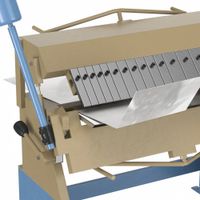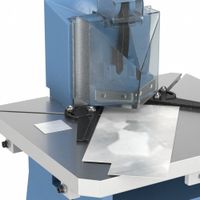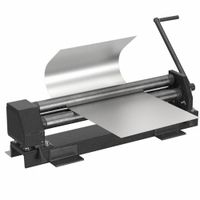Call +(254) 703 030 000 / 751 483 999 / 721 704 777
.....Read More
Frequently Asked Questions
What are the different types of metal fabrication machines?
Metal fabrication involves various machines, each designed for specific tasks. Key types include:
1. **Cutting Machines**:
- **Laser Cutters**: Use laser beams for precise cuts.
- **Plasma Cutters**: Employ ionized gas for cutting thick metals.
- **Waterjet Cutters**: Utilize high-pressure water, sometimes mixed with abrasives, for cutting without heat.
2. **Bending Machines**:
- **Press Brakes**: Bend metal sheets into desired angles using a punch and die.
- **Tube Benders**: Specifically designed for bending pipes and tubes.
3. **Shearing Machines**:
- Use blades to cut straight lines in metal sheets.
4. **Punching Machines**:
- Create holes in metal using a punch and die mechanism.
5. **Rolling Machines**:
- **Plate Rollers**: Roll metal sheets into cylindrical shapes.
- **Angle Rollers**: Bend metal bars and angles into curves.
6. **Welding Machines**:
- **MIG, TIG, and Stick Welders**: Fuse metal pieces together using different welding techniques.
7. **Stamping Machines**:
- Use dies to shape or cut metal by pressing it into a mold.
8. **Grinding Machines**:
- Smooth and finish metal surfaces using abrasive wheels.
9. **CNC Machines**:
- Computer-controlled machines for precise cutting, drilling, and shaping.
10. **Sawing Machines**:
- **Band Saws and Circular Saws**: Cut metal using toothed blades.
11. **Notching Machines**:
- Cut notches or angles in metal sheets or bars.
These machines are essential in transforming raw metal into finished products, each serving a unique role in the fabrication process.
How do brakes and bending machines work?
Brakes and bending machines are essential tools in metalworking, used to shape and form metal sheets into desired angles and configurations.
Brakes, specifically press brakes, operate by clamping a metal sheet between a matching punch and die. The punch, attached to a ram, descends onto the sheet, forcing it into the die, which is fixed to the machine's bed. This action bends the metal at a precise angle. The process is controlled by adjusting the ram's stroke and the die's shape, allowing for various bend angles and radii. Modern press brakes often use CNC (Computer Numerical Control) systems for precision and repeatability, enabling complex bending sequences and high production efficiency.
Bending machines, on the other hand, encompass a broader category, including roll benders and tube benders. Roll benders use a set of rollers to gradually shape metal sheets or bars into curves or circles. The metal is passed through the rollers, which apply pressure to bend it incrementally. Tube benders specifically shape pipes and tubes, using dies and mandrels to prevent collapse and ensure uniform bends. These machines can be manual, hydraulic, or CNC-controlled, offering varying degrees of automation and precision.
Both brakes and bending machines rely on principles of force and leverage to deform metal without breaking it. The choice between them depends on the specific requirements of the task, such as the type of material, thickness, and desired shape. Proper tooling and machine settings are crucial to achieving accurate and consistent results, making these machines indispensable in manufacturing and fabrication industries.
What is the purpose of rolling machines in metal fabrication?
Rolling machines in metal fabrication are used to shape and form metal into desired profiles and dimensions. Their primary purpose is to reduce the thickness of metal sheets or to create uniform curves and cylindrical shapes. This process, known as rolling, involves passing metal stock through one or more pairs of rolls to achieve the desired thickness and shape.
There are several types of rolling machines, including:
1. **Plate Rolling Machines**: These are used to roll metal plates into cylindrical or conical shapes. They are essential in manufacturing pipes, tanks, and pressure vessels.
2. **Section Rolling Machines**: These machines are used to bend metal sections like angles, beams, and channels into arcs or circles, often used in construction and structural applications.
3. **Ring Rolling Machines**: These are specialized for producing seamless rings, often used in aerospace, automotive, and energy industries.
4. **Thread Rolling Machines**: These machines form threads on metal parts by rolling, which enhances the strength and surface finish of the threads compared to cutting methods.
The rolling process offers several advantages:
- **Material Efficiency**: Rolling can produce large quantities of uniform products with minimal waste.
- **Improved Mechanical Properties**: The process can enhance the strength and hardness of metals through work hardening.
- **Surface Finish**: Rolling can improve the surface finish of metal products, reducing the need for additional finishing processes.
- **Versatility**: Rolling machines can handle a wide range of metals and alloys, including steel, aluminum, and copper.
Overall, rolling machines are crucial in metal fabrication for their ability to efficiently produce high-quality, consistent, and precise metal components for various industrial applications.
How do shearing machines achieve clean cuts on metal?
Shearing machines achieve clean cuts on metal through a combination of precise mechanical action and optimal design. The process involves a set of upper and lower blades, where the upper blade descends onto the metal sheet, which is held in place by a hold-down mechanism. The blades are typically made from hardened steel to maintain sharpness and durability.
The key to a clean cut lies in the shearing action, which is a straight-line cutting process. The blades are set at a slight angle, known as the rake angle, which reduces the force required to cut through the metal. This angle allows the cut to initiate at one point and progress smoothly across the material, minimizing distortion and burrs.
The clearance between the blades is another critical factor. It is the gap that allows the metal to be sheared without excessive force, typically set to a small percentage of the material's thickness. Proper clearance ensures that the metal is cut rather than torn, resulting in a smooth edge.
Additionally, the shearing machine's rigidity and stability are crucial. A robust frame minimizes vibrations and deflections during the cutting process, contributing to precision and consistency. The use of hydraulic or mechanical systems to control the blade movement ensures uniform pressure and speed, further enhancing the quality of the cut.
Finally, regular maintenance, including sharpening and aligning the blades, is essential to maintain the machine's performance. By combining these elements, shearing machines can produce clean, precise cuts on various metal types and thicknesses.
What are the applications of notching and punching machines?
Notching and punching machines are essential tools in metalworking and manufacturing, offering a range of applications across various industries:
1. **Sheet Metal Fabrication**: These machines are widely used in the fabrication of sheet metal components. Notching machines create precise angles and shapes on the edges of metal sheets, while punching machines make holes or cutouts, facilitating the assembly of complex structures.
2. **Automotive Industry**: In automotive manufacturing, notching and punching machines are employed to produce parts like brackets, panels, and frames. They ensure high precision and repeatability, which are crucial for the safety and performance of vehicles.
3. **Construction and Architecture**: These machines are used to create metal components for building structures, such as beams, columns, and trusses. They help in producing custom metal parts that fit specific architectural designs and structural requirements.
4. **Electrical and Electronics**: Notching and punching machines are used to manufacture enclosures, panels, and chassis for electrical and electronic devices. They provide the necessary cutouts for switches, connectors, and other components, ensuring proper fit and function.
5. **Aerospace Industry**: In aerospace, precision and reliability are paramount. Notching and punching machines are used to fabricate lightweight and durable components for aircraft, such as brackets, supports, and panels, contributing to the overall efficiency and safety of the aircraft.
6. **HVAC Systems**: These machines are used to produce ductwork and other components for heating, ventilation, and air conditioning systems. They allow for the creation of custom shapes and sizes, ensuring efficient airflow and system performance.
7. **Furniture Manufacturing**: In the production of metal furniture, notching and punching machines are used to create joints, connectors, and decorative elements, enhancing both the functionality and aesthetic appeal of the products.
Overall, notching and punching machines are versatile tools that enhance productivity, precision, and customization in various manufacturing processes.
How do shaping machines form and finish domed workpieces?
Shaping machines form and finish domed workpieces through a process involving a reciprocating cutting tool and a workpiece mounted on a table. The shaping machine operates by moving the cutting tool back and forth in a linear motion, while the workpiece is incrementally fed into the tool's path.
To create a domed shape, the workpiece is typically mounted on a rotary table or a specially designed fixture that allows it to be rotated or tilted at precise angles. This setup enables the cutting tool to gradually remove material from the workpiece's surface, following a predetermined path that corresponds to the desired dome profile. The shaping machine's tool head can be adjusted to various angles and depths, allowing for the creation of complex curves and contours.
The process begins with rough shaping, where larger amounts of material are removed to approximate the dome's basic form. This is followed by finer passes, where the tool makes smaller, more precise cuts to achieve the final shape and surface finish. The cutting tool's speed, feed rate, and depth of cut are carefully controlled to ensure accuracy and prevent tool wear or damage to the workpiece.
Finishing operations may involve additional processes such as grinding, polishing, or honing to achieve the required surface smoothness and dimensional accuracy. These finishing steps are crucial for applications where the domed workpiece must meet stringent specifications, such as in aerospace or automotive industries.
Overall, shaping machines provide a versatile and precise method for forming and finishing domed workpieces, leveraging their ability to handle complex geometries and deliver high-quality surface finishes.
What functions can ironworkers and combination machines perform?
Ironworkers and combination machines are versatile tools used in metalworking and fabrication industries. They perform a variety of functions essential for shaping and assembling metal components.
Ironworkers are primarily used for:
1. **Punching**: Creating holes in metal sheets or plates with precision. This is crucial for preparing materials for assembly or further processing.
2. **Shearing**: Cutting metal sheets, bars, or angles to size. This function allows for quick and efficient material preparation.
3. **Notching**: Removing sections from the edge of metal sheets or plates, often used to create joints or prepare materials for welding.
4. **Bending**: Forming metal into desired angles or shapes. This is essential for creating components that fit specific design requirements.
5. **Coping**: Cutting the end of a metal piece to fit against another piece, often used in structural applications.
Combination machines integrate multiple functions into a single unit, offering:
1. **Drilling**: Creating precise holes in metal, often used in conjunction with other functions for comprehensive fabrication.
2. **Grinding**: Smoothing or finishing metal surfaces, essential for preparing materials for painting or coating.
3. **Sawing**: Cutting metal with precision, often used for creating complex shapes or components.
4. **Rolling**: Forming metal sheets into cylindrical shapes, used in creating pipes or curved components.
5. **Pressing**: Applying force to shape or join metal components, often used in assembly processes.
These machines enhance productivity by combining multiple operations, reducing the need for separate equipment, and streamlining the fabrication process. They are essential in industries such as construction, automotive, and manufacturing, where efficiency and precision are paramount.





